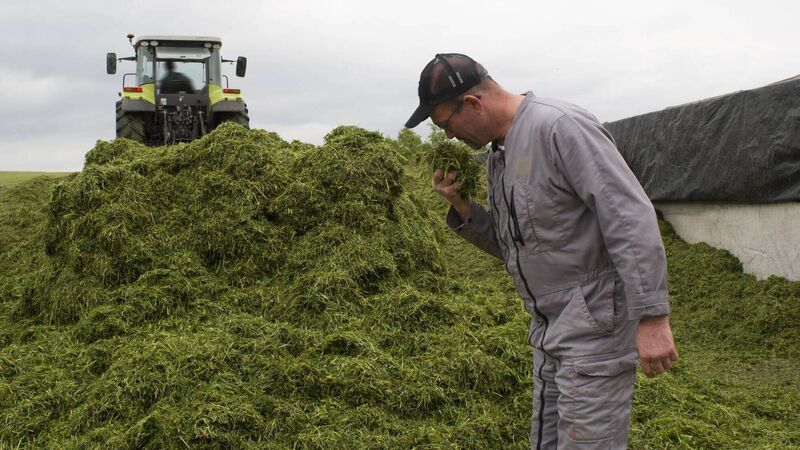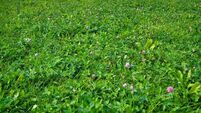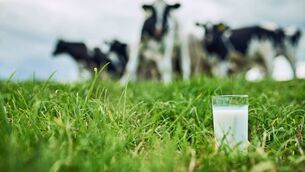What can we learn from 1,100 Irish silage samples?

Getting the fundamentals right at the start is the key to making good silage. Picture: Frédéric Michel / iStock.
Quality silage pays for itself Many farms learned the hard way this year about the need to have reserves of good quality silage.
When cows are stuck indoors, silage makes up the majority of the diet, and no matter what levels of concentrate we feed, we will find it hard to get enough energy into the diet when cows need it the most.
A lot of silage is being made at the moment, and the quality of this should be quite good. Where possible, it is beneficial to graze off the silage ground early in the year to try to clean off any dead material that has been lying over the winter, but this year, with the poor weather at the start of the year, this was difficult to do.
Fertiliser was late going out this spring, and this may result in some farmers wanting to push silage-making back to later in the year.
The growing crop will use two units a day, so if you applied 80 units, you should wait roughly 40 days from when you last applied fertiliser before cutting.
But this is just a rough rule of thumb. If you are worried about it, you can get a fresh grass sample tested. A lot of feed mills have the capability of doing this test.
There is no bank of silage left in many yards, and some people will be considering holding on for a big first cut — but high-quality silage is important too, especially when you take into account the cost of concentrates needed to balance poorer-quality silage.
By increasing the protein of your silage, you can decrease the protein level of the concentrates you’re buying. This will significantly reduce costs, as protein is always the most expensive aspect of the ration.
Ensuring the availability of high-quality silage at the shoulders of the year, when cows are milking while indoors, is essential for maximising productivity following calving.
We speak about offering high-quality swards to herds throughout the entire grazing season, and we should have the same mindset for silage.
The use of silage in diets is no longer just for the dry cow period but often from October to April. This winter gone by silage was fed in September in a lot of yards due to reasons outside of our control, and the delayed spring resulted in silage being fed up with the end of April. That is eight months, with silage being somewhat present in the herds’ diet.
As advisors and farmers, we must finally realize that it is no longer acceptable to just blame the weather for poor silage quality because there are multiple factors to be considered.
Unfortunately, the weather is outside our control, and we need to focus on controlling aspects of the job that we can control.
The primary advantage of high-quality silage lies in its ability to preserve the nutritional content of the forage.
The aim is to turn the grass into silage, while trying to achieve a quality silage as similar to grass as possible.
Silage undergoes fermentation, a process that converts sugars into lactic acid, thereby preserving the forage. This fermentation process helps in breaking down complex carbohydrates into simpler, more digestible forms.
As a result, livestock consuming high-quality silage experience better production, increased milk production, and improved milk quality.
For beef cattle, high-quality silage helps them thrive, leading to better weight gain and maximising the profitability of the farm.
Silage quality can vary from farm to farm, so it is vital to get it tested annually to see how well or how badly the silage has been preserved from harvest to pitting.
Over the course of the past year, InTouch nutritionists at Alltech have taken over 1,100 silage samples.
The table below outlines the average of quality across first and second cuts across all farms sampled.
###TABLE###
Another significant benefit of high-quality silage is its improved palatability. Animals are more likely to consume feed that is fresh, sweet-smelling, and free from mould and spoilage.
Properly fermented silage is more appealing to livestock, encouraging consistent feed intake. This is crucial because any reduction in feed consumption can lead to a drop in productivity. The more dry matter we can get the animal to eat, the more fuel she has in the tank to drive on milk yield or weight gain.
Care should be taken this year when it comes to mowing. Raising the cutting height to 6cm when mowing will have a positive effect on silage quality and will reduce the amount of ash in the crop.
A lot of slurry and fertiliser was spread in less-than-ideal conditions this year, and some damage was done in fields.
Try to avoid bringing in any clay at all with the crop, as this can lead to issues with fermentation and a higher risk from mycotoxins.
The time of day that you cut, along with the conditions under which the crop is mowed, will also affect overall quality of the crop.
Ideally, the silage crop should be spread out immediately behind the mower in order to begin a rapid wilt to lift the dry matter. Crops that achieve a rapid wilt can be picked up within 24 hours. Ideally, sugars in grass silage at the time of cutting should be higher than 3%.
This leaves a narrow window to get a crop mown, but when the feed will be present in the diet for up to seven months of the year, a few days’ work is a small price to pay for better-quality silage.
The wetter the crop, the longer the chop length can be. Wetter silage under 25% dry matter can have a chop length of 30–50 mm. Getting the chop length right leads to a strong beginning for the fermentation process.
A good fermentation also requires the silage clamp to be filled efficiently, achieving high levels of compaction to squeeze the air out.
A big issue we are seeing is pits being filled too fast and not enough rolling being done. Silage is made in the pit, and all air needs to be squeezed out, as any air not excluded will affect fermentation and reduce silage quality. Aim to have high levels of compaction by using compactors on silage pits.
The use of clingfilm layers has also greatly reduced the level of waste in silage pits, due to the airtight seal.
Once the silage pit is covered, the gold standard is to have the tyres touching, as the silage pit needs weight to help maintain an airtight seal.
Year on year, it has become evident that good-quality grass silage plays a crucial role in all production systems across dairy and beef farms.
Without a doubt, it is important to have enough silage to meet the demands of your herd, but not all silage is created equal.
By staying informed about best practices in silage-making, and by planning well and taking a few extra steps as described here, you can make silage that will bring huge benefits to your herd throughout the year.
To learn more about making the most of your silage, including easy options for testing and analysis, reach out to your Alltech representative.










